Research
Photosynthetic Light-harvesting and Artificial Photosynthesis: Structure elucidation of photosynthetic pigments
Green plants are throwing away the green regions of sunlight. But since only green light can reach the sea bottom, marine photosynthetic organisms use green light with high efficiency to carry out photosynthesis. Photosynthetic pigments bound to proteins capture such light energy and transfer the excitation energy to the photosynthetic reaction center. In recent years, we have been trying to elucidate the structure and function of pigments that bind to light-harvesting antennas of marine photosynthetic organisms. In particular, I am interested in "carotenoids" such as siphonaxanthin shown below.
Recently, we have proceeded with mass cultivation of marine algae, such as brown algae or green algae, in its "seed" state before implantation. We aim to elucidate the versatile role of the photosynthetic light-harvesting system by determining its structure and pigment compositions.
Our group is mainly engaged in cultivation ((micro)biology), purification of proteins (biochemistry) and pigments (natural product chemistry), and optical spectroscopy. Joint research theme includes genetic modification (metabolic engineering), photosynthetic response during growth (plant physiology), crystallization of pigment-binding proteins for X-ray crystallography, and elucidation of high-resolution structures by cryogenic-electron microscopy (structural biology). We are currently working on the following research themes.
Structure and function of unique pigments in colorful photosynthetic light-harvesting systems
Structure of siphonaxanthin bound to the photosynthetic antenna of a marine macroalga, Codium fragile
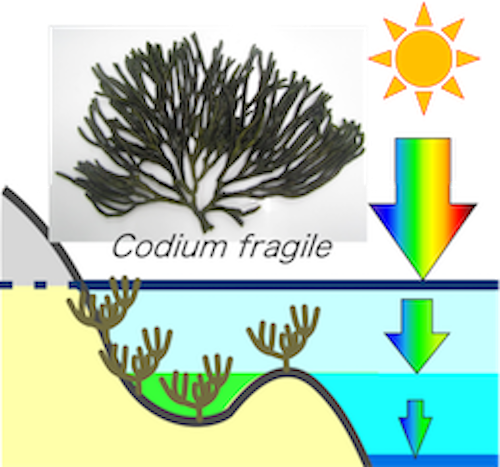
A green macroalga, Codium fragile growing on the seafloor in the intertidal zone undergoes photosynthesis in an environment where the color and intensity of light constantly change from strong white to weak blue-green due to changes in water depth due to tides.
It has been known since the 1980s that siphonaxanthin bound to the photosynthetic antenna of Codium species absorbs green light and utilizes its energy for photosynthesis, but structural information on the photosynthetic antenna has not yet been obtained.
In recent years, siphonaxanthin has attracted attention as a dietary supplement and pharmaceutical with anti-inflammatory and anti-obesity effects, but the lack of large-scale sources is a challenge.
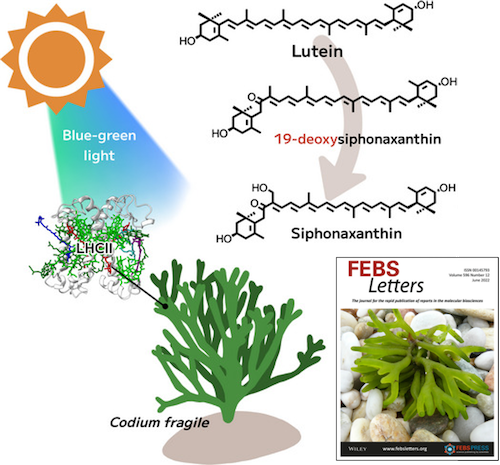
Using the Codium cultivated in the filamentous form, we found that siphonaxanthin biosynthesis was inhibited by intense blue-green light and that the precursor deoxysiphonaxanthin accumulated in the photosynthetic antennae. (FEBS Lett. 2022)
<This is a joint research project with Dr. Yumiko Yamano of Kobe Pharmaceutical University, Dr. Naohiro Oka of Tokushima University, and Dr. Yasuhiro Kamei of the National Institute for Basic Biology (NIBB).>
Until now, the biosynthetic pathway of siphonaxanthin was thought to be via loroxanthin, which is an OH-bonded methyl group at position 19 of lutein. Deoxysiphonaxanthin, which was newly discovered as a precursor, overturned this common sense. This study is the first to provide experimental evidence for a siphonaxanthin biosynthetic pathway. It is expected that research on siphonaxanthin biosynthetic enzymes will progress in the future. This research is ongoing.
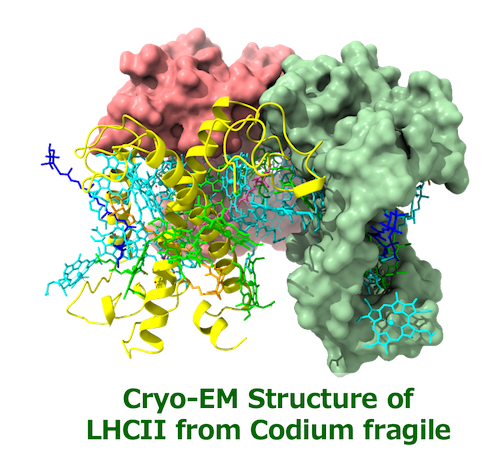
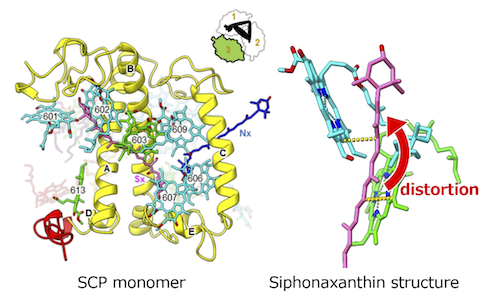
We have elucidated the atomic resolution structure (2.78 Å) of the photosynthetic antenna of the green algal mill by cryo-electron microscopy. From this structure, we identified the twist structure of siphonaxanthin, which can cause the unique green absorption band and the two sites where chlorophyll a is replaced by chlorophyll b. (BBA Advances, 2022) Press ReleaseFaceBookTwitter
<This is a joint research project with Dr. Genji Kurisu (Institute for Protein Research, Osaka University) and Dr. Sen Ura (ThermoFisher Scientific).>
The atomic resolution structure of LHCII, a photosynthetic antenna from land plants was reported around 2004 by X-ray crystallography. However, this is the first atomic resolution structure of a pigment-altered LHCII from green algae.
By combining the results of quantum chemical calculations based on this structure and the consequences of ultrafast spectroscopy, we can expect to deepen our understanding of the energy transfer mechanism of photosynthetic antennas. This research is ongoing.
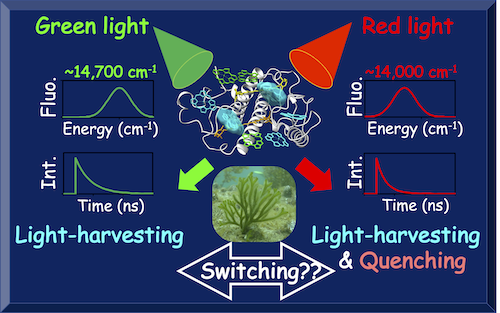
Performing single-particle spectroscopy of the photosynthetic antennae SCP, we found that the low-energy, short-lived fluorescence signature of quenching increased significantly only upon excitation by red light. This phenomenon has not been observed in plant LHCII, so it should be SCP-specific. (J. Phys. Chem. Lett, 2022)
<This is joint research with Professor J.Köhler (the University of Bayreuth, Germany).>
This phenomenon may be related to the molecular mechanism by which SCP switches between focused and resting states. Research is ongoing.